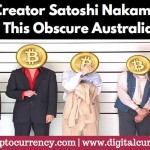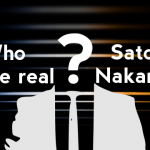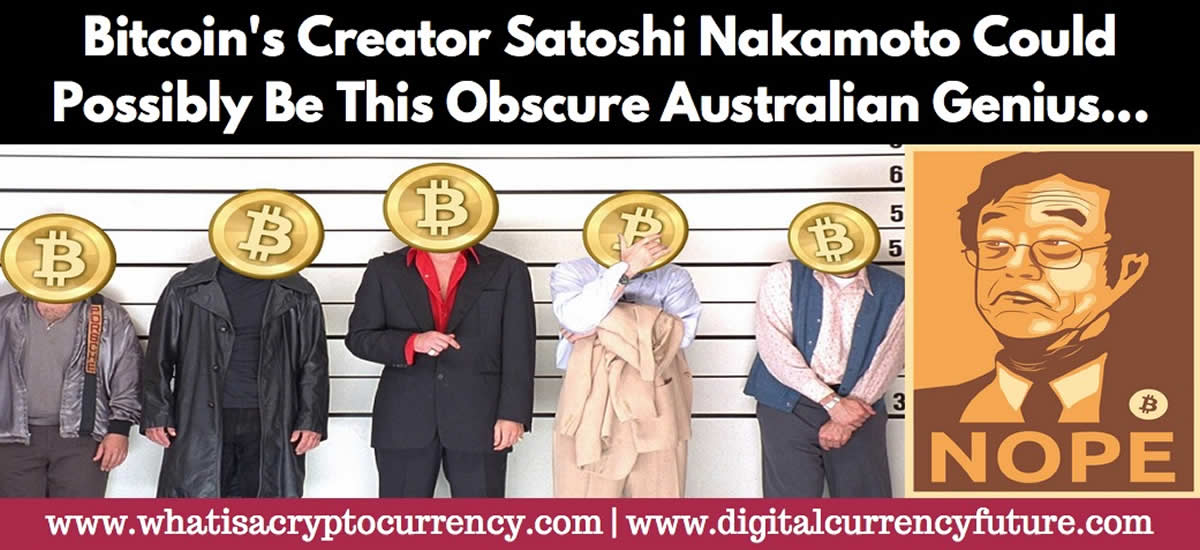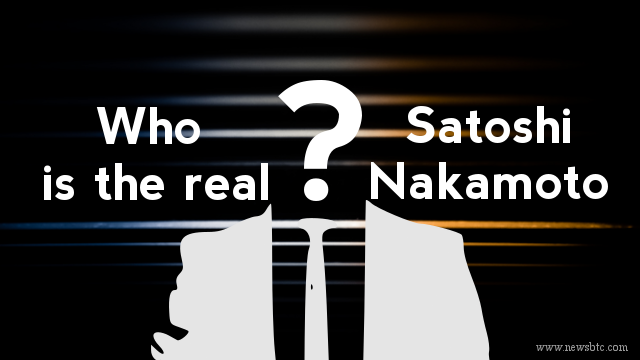The creator of bitcoin / cryptocurrency is a secretive entity named Satoshi Nakamoto. Some like to believe it’s a collective of people, and others think that there is an actual Satoshi who is the mastermind behind it all. The following article is intriguing, as it suggests a possibility of the true identity of Satoshi Nakamoto. Who is right? Read on and come to your conclusion!
Could it be the elusive Satoshi Nakamoto? EVEN AS HIS face towered 10 feet above the crowd at the Bitcoin Investor’s Conference in Las Vegas, Craig Steven Wright was, to most of the audience of crypto and finance geeks, a nobody.
The 44-year-old Australian, Skyping into the D Hotel ballroom’s screen, wore the bitcoin enthusiast’s equivalent of camouflage: a black blazer and a tieless, rumpled shirt, his brown hair neatly parted. His name hadn’t made the conference’s list of “featured speakers.”
Even the panel’s moderator, a bitcoin blogger named Michele Seven, seemed concerned the audience wouldn’t know why he was there. Wright had hardly begun to introduce himself as a “former academic who does research that no one ever hears about,” when she interrupted him.
“Hold on a second, who are you?” Seven cuts in, laughing. “Are you a computer scientist?”
“I’m a bit of everything,” [actually bullshit] Wright responded. “I have a master’s in law…a master’s in statistics, a couple doctorates…”
“How did you first learn about bitcoin?” Seven interrupted again as if still trying to clarify Wright’s significance.
Wright paused for three full seconds. “Um. I’ve been involved with all this for a long time,” he stuttered. “I—try and stay—I keep my head down. Um…” He seemed to suppress a smile. The panel’s moderator moved on. And for what must have been the thousandth time in his last seven years of obscurity, Wright did not say the words WIRED’s study of Wright over the past weeks suggests he may be dying to say out loud.
“I am Satoshi Nakamoto, the creator of bitcoin.” [Liar]
Either Wright invented bitcoin, or he’s a brilliant hoaxer who very badly wants us to believe he did.
Since that pseudonymous figure first released bitcoin’s code on January 9, 2009, Nakamoto’s ingenious digital currency has grown from a nerd novelty to a kind of economic miracle. As it’s been adopted for everything from international money transfers to online narcotrafficking, the total value of all bitcoins has grown to nearly $5 billion. Nakamoto himself, whoever he is, appears to control a stash of bitcoins easily worth a nine-figure fortune (it rose to more than a billion at the cryptocurrency peak exchange rate in 2014). But the true identity of bitcoin’s creator remains a cipher. Media outlets from the New Yorker to Fast Company to Newsweek have launched investigations into unmasking Nakamoto that were either inconclusive or, in Newsweek’s case, pointed to a man who subsequently denied having anything to do with cryptography, not to mention cryptocurrency. Altogether, the world’s Satoshi-seekers have hardly put a dent in one of the most stubborn mysteries of the 21st century, one whose answer could resonate beyond a small sphere of crypto geeks and have real economic effects.
In recent weeks, WIRED obtained some weak evidence of Satoshi Nakamoto’s true identity. They tried to claim that these signs point to Craig Steven Wright, a man who never even made it onto any Nakamoto hunters’ public list of candidates. But is a not so brilliant hoaxer who very badly wants us to believe he is Satoshi Nakamoto.
The Evidence Of A Possible Satoshi Nakamoto? Pfff…
These were the first signs that Wright could be the elusive Satoshi Nakamoto. While it seems obvious, could it have been an elaborate hoax?
Here is what they claim was the evidence: The first bit pointing to Wright appeared in mid-November when an anonymous source close to Wright began leaking documents to Gwern Branwen, a pseudonymous, independent security researcher, and dark web analyst. Branwen provided those documents to WIRED, and they immediately led to several direct, publicly visible connections between Nakamoto and Wright:
In August 2008, a was created post on Wright’s blog, months before the November 2008 introduction of the bitcoin white paper on a cryptography mailing list. The post mentions his intention to release a “cryptocurrency paper,” and references “triple entry accounting,” the title of a 2005 paper by financial cryptographer Ian Grigg, that outlines several bitcoin-like ideas.
A post on the same blog from November 2008 includes a request that readers who want to get in touch encrypt their messages to him using a PGP public key linked to Satoshi Nakamoto. A PGP key is a unique string of characters that allows a user of that encryption software to receive encrypted messages. This one, when checked against the database of the MIT server where it was stored, is associated with the email address satoshin@vistomail.com, an email address very similar to the satoshi@vistomail.com address Nakamoto used to send the whitepaper introducing bitcoin to a cryptography mailing list.
An archived copy of a now-deleted blog post from Wright dated January 10, 2009, which reads: “The Beta of Bitcoin is live tomorrow. This is decentralized… We try until it works.” (The post was dated January 10, 2009, a day after Bitcoin’s official launch on January 9 of that year. But if Wright, living in Eastern Australia, posted it after midnight his time on the night of the 9th, that would have still been before bitcoin’s launch at 3 pm EST on the 9th.) That post was later replaced with the rather cryptic text “Bitcoin – AKA bloody nosey you be…It does always surprise me how, at times, the best place to hide [is] right in the open.” Sometime after October of this year, it was deleted entirely.
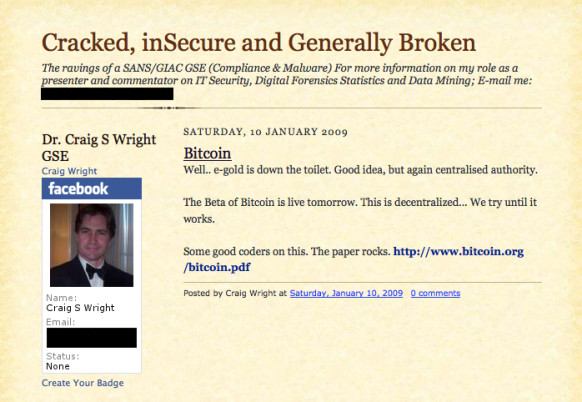
[A screenshot from Craig Wright’s blog showing his apparent plan to launch Bitcoin, the post has since been removed. WIRED]
In addition to those three blog posts, we received a cache of leaked emails, transcripts, and accounting forms that corroborate the link. There’s a leaked message from Wright to his lawyer date June 2008 in which Wright imagines “a P2P distributed ledger”—an apparent reference to bitcoin’s public record of transactions known as the blockchain, long before it was publicly released. The email goes on to reference a paper called “Electronic Cash Without a Trusted Third Party” that Wright expected to release in 2009.
Another leaked email from Wright to computer forensics analyst David Kleiman, a close friend and confidant, just before bitcoin’s January 2009 launch, discusses a paper they’d been working on together. Wright talks about taking a buyout from his job and investing in hundreds of computer processors to “get [his] idea going.” There’s also a PDF authored by Kleiman, who died in April of 2013, in which he agrees to take control of a trust fund, codenamed the “Tulip Trust,” containing 1.1 million bitcoins. The PDF is signed with Kleiman’s PGP signature, a cryptographic technique that ensures it couldn’t have been altered post-signature.
That million-coin trove—The Tulip Trust—is the same size as a mysterious bitcoin fortune that’s long been visible on bitcoin’s blockchain and widely attributed to Satoshi Nakamoto. No one but Nakamoto is known to have assembled such a massive hoard of the cryptocurrency, and only Nakamoto could have generated so many bitcoins so early in its evolution when a bitcoin could be “mined” with relatively small amounts of processing power. Only one such bitcoin mega pile exists, and the closely-watched coins haven’t moved in bitcoin’s entire history.
Another clue as to Wright’s bitcoin fortune wasn’t leaked to WIRED. Instead, it remained hosted on the website of the corporate advisory firm McGrathNicol: a liquidation report on one of several companies Wright founded known as Hotwire, an attempt to create a bitcoin-based bank. It shows that the startup was backed in June 2013 by $23 million in bitcoins owned by Wright. That sum would be worth more than $60 million today. At the time of the company’s incorporation, Wright’s investment in that one firm alone represented more than 1.5 percent of all existing bitcoins, a strangely large stash for an unknown player in the bitcoin world.
The giveaways go on: There’s a leaked email from Wright to an associate in January 2014 about a tax dispute with the Australian government. In it, he seems to consider using Nakamoto’s name to wield influence with New South Wales Senator Arthur Sinodinos “Would our Japanese friend have weight coming out of retirement?” Wright asks. It includes a draft email to the senator signed “Satoshi Nakamoto.” And a leaked transcript of Wright’s meeting with attorneys and tax officials in February 2014 quotes him in a moment of exasperation: “I did my best to try and hide the fact that I’ve been running bitcoin since 2009,” Wright says. “By the end of this, I think half the world is going to bloody know.”
Making Contact With Satoshi Nakamoto
 The possible Satoshi Nakamoto proved to be rather cryptic and difficult to communicate with. What ensued when Wired made contact with Dr. Wright proved to be quite interesting.
The possible Satoshi Nakamoto proved to be rather cryptic and difficult to communicate with. What ensued when Wired made contact with Dr. Wright proved to be quite interesting.
On December 1, WIRED sent an encrypted email to Wright, suggesting that we knew his secret and asking for a meeting. A few hours later, we received a wary response from the address Tessier-Ashpool@AnonymousSpeech.com, a cyberpunk reference to a rich and powerful corporate dynasty in William Gibson’s Sprawl trilogy. Wright had referenced the same fictional family in the bio of his private twitter profile. The email’s IP showed that it came from an IP address in Panama controlled by Vistomail, the same service that Satoshi Nakamoto had used to send his emails introducing bitcoin and run Bitcoin.org. “This is a throw-away account. There are ways even with [the anonymity software] Tor, but the people in Panama are extremely [sic] good and do not violate people’s desired privacy,” the email read. “You are digging; the question is, how deep are you?” The message ended, “Regards, the Director of Tessier-Ashpool.”
After WIRED sent an encrypted email to Wright suggesting that we knew his secret, we received a perplexing message: ‘You seem to know a few things. More than you should.’
A few hours later, we received another, even more, perplexing message from the same account. “The nature of this moniker is selected for a purpose. I now have resources. This makes me a we now. I am still within that early phase of learning just what my capabilities happen to be. So, even now, with resources, I remain vulnerable,” it read. “You seem to know a few things. More than you should.”
When we responded by describing the three blog posts that showed Wright’s apparent connection to bitcoin’s creation and asking again for a meeting, he gave a revealing answer. “Although we all desire some level of credit, I have moved past many of these things,” read his response from the same Tessier-Ashpool account. “Too many already know secrets the world does not need to know. There are other means to lead change than to be a dictator.”
After our second follow up message asking for a chance to talk, Wright responded that he would consider our request. Then he stopped responding altogether.
Satoshi Nakamoto Dropping Breadcrumbs?

Despite that overwhelming collection of clues, none of it sufficiently proves that Wright is Nakamoto. All of it could be an elaborate hoax—perhaps orchestrated by Wright himself. The unverified leaked documents could be faked in whole or in part. And most inexplicably of all, comparisons of different archived versions of the three smoking gun posts from Wright’s blog show that he did edit all three—to insert evidence of his bitcoin history. The PGP key associated with Nakamoto’s email address and references to an upcoming “cryptocurrency paper” and “triple entry accounting” was added sometime after 2013. Even the post noting bitcoin’s beta launch is questionable. While it was ostensibly posted in January 2009, it later seems to have been deleted and then un-deleted – or possibly even written for the first time – sometime between October 2013 and June of 2014.
Wright’s blog, his public records, and his verified writings on mail lists and Twitter sketch a man who matches with Satoshi Nakamoto’s known characteristics well enough to place him leagues above other candidates.
Why those breadcrumbs were dropped remains a mystery. Is Wright trying to steal Nakamoto’s glory (or money) falsely? Is he quietly revealing himself as bitcoin’s creator?
But this much is clear: If Wright is seeking to fake his Nakamoto connection, his hoax would be practically as ambitious as bitcoin itself. Some of the clues added to his blog were made more than 20 months ago—a very patient deception if it were one. His references to Grigg’s “triple entry accounting” paper would represent an uncannily inventive lie, representing a new and obscure possible inspiration for bitcoin. And there’s little doubt Wright is a certified bitcoin mogul. Even the $60 million portion of his cryptocurrency stash that’s verifiable in McGrathNicol’s public audit record is suspiciously large.
More circumstantially, Wright’s blog, his public records, and his verified writings on mail lists and Twitter sketch a man who matches with Satoshi Nakamoto’s known characteristics well enough to place him leagues above other candidates. He’s a former subscriber to the 1990s “cypherpunks” mailing list devoted to anti-authoritarianism and encryption, an advocate of gold as a financial tool, an accomplished C++ coder, a security professional plausibly capable of writing a tough-to-hack protocol like bitcoin, a libertarian who battled with tax authorities, and a fan of Japanese culture.
He is also—parallels to Nakamoto aside—a strange and remarkable person: an almost obsessive autodidact and double-PhD who once boasted of obtaining new graduate degrees at a rate of about one a year. He’s a climate-change denier, a serial entrepreneur who started companies ranging from security consultancies to a bitcoin bank, and an eccentric who wrote on his blog that he once accepted a challenge to create a pencil from scratch and spent years on the problem, going so far as to make his own bricks to build his own kiln in which to mix the pencil’s graphite.
Wright’s blogging and leaked emails describe a man so committed to an unproven cryptocurrency idea that he mortgaged three properties and invested more than $1 million in computers, power, and connectivity—even going so far as to lay fiberoptic cables to his remote rural home in eastern Australia to mine the first bitcoins. His company, Tulip Trading, built two supercomputers that have officially ranked among the top 500 in the world, both seemingly related to his cryptocurrency projects. (Wright seems to enjoy tulip references, a likely taunt at those who have compared bitcoin to the Netherlands’ 17th century “tulip bubble.”) The first of those supercomputers he named Sukuriputo Okane—Japanese for “script money.” Another, named Co1n, holds the title of the world’s most powerful privately owned supercomputer. As Wright told the Bitcoin Investor’s conference, he’s applying that second machine towards the mysterious task of “modeling Bitcoin’s scalability,” and meanwhile building an even more powerful supercomputing cluster in Iceland because of its cheap geothermal power.
Bitcoin watchers have long wondered why the giant cache of coins they attribute to Satoshi Nakamoto never moved on the bitcoin’s publicly visible blockchain. Wright’s “Tulip” trust fund of 1.1 million bitcoins may hold the key to that mystery. The trust fund PDF signed by Wright’s late friend David Kleiman keeps those coins locked in place until 2020, yet gives Wright the freedom to borrow them for applications including “research into peer-to-peer systems” and “commercial activities that enhance the value and position of bitcoin.”
Despite those exceptions to the trust’s rules, the million-coin hoard has yet to budge, even after Kleiman’s death in 2013. That may be because Wright could be keeping the coins in place as an investment. He could be leveraging the trust in less visible ways, like legally transferring ownership of money to fund his companies while still leaving it at the same bitcoin address. Or he might still be waiting for January 1, 2020, a countdown to a date that could take the lid off the most substantial cryptocurrency fortune in history.
Satoshi Nakamoto Coming Clean.. Or Not?
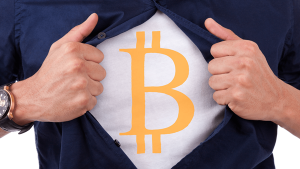 And so while there were many signs that Wright could have either been Satoshi Nakamoto or was working closely with him or people that were. There are some serious points of data that put it all into question.
And so while there were many signs that Wright could have either been Satoshi Nakamoto or was working closely with him or people that were. There are some serious points of data that put it all into question.
Despite all the clues as to Wright’s possible secret life—some that he clearly placed himself—Wright has demonstrated such a talent for obfuscation and love of privacy that he’s never even raised the suspicions of most Nakamoto-worshipping bitcoiners. “If we don’t want to go out there and say ‘I’m a billionaire,’ or ‘I’m running XYZ,’ or ‘this is my life,’ I shouldn’t have to tell people that,” Wright told the Las Vegas crowd in October when an audience member asked his thoughts about what bitcoin means for property rights. “We should be able to choose how we live.”
In the leaked emails, Wright seems to bristle at the few times anyone has attempted to out bitcoin’s creator. “I am not from the bloody USA! Nor am I called Dorien [sic],” reads a message from Wright to a colleague dated March 6, 2014. That’s the same day as Newsweek’s widely discredited story claimed the inventor of bitcoin to be the American Dorian Satoshi Nakamoto.
If Wright is bitcoin’s creator, the revelation of his work carries more importance than merely sating the curiosity of a few million geeks.
Wright seemed to take personal offense at the Newsweek story. “I do not want to be your poster boy. I am not found, and I do not want to be,” he writes in another message the same day. The email addressed to a colleague and titled “please leak,” may have been an early draft of the Nakamoto’s posted denial of Newsweek’s story. That public denial, a rare message from Nakamoto posted from his account on the P2P Foundation forum, simply read, “I am not Dorian Nakamoto.” But Wright’s private response was far angrier. “Stop looking… Do you know what privacy means? A gift freely given is just that and no more!”
At times, however, Wright has seemed practically envious of Nakamoto. “People love my secret identity and hate me,” he complained to Kleiman in a leaked email from 2011. “I have hundreds of papers. Satoshi has one. Nothing, just one bloody paper, and I [can’t] associate myself with ME!”
If Wright is bitcoin’s creator, the revelation of his work carries more importance than merely sating the curiosity of a few million geeks. The bitcoin economy would need to consider that if his million-bitcoin trust unlocks in 2020, Wright and those to whom he may have assigned hundreds of thousands of bitcoins would be free to sell them on the open market, potentially tanking the cryptocurrency’s price; debates within the bitcoin community like the current dispute over bitcoin’s “block size” may look to long-lost Nakamoto for guidance; the world would have to grapple with the full scope of Wright’s vision when he unleashes the result of his companies’ post-bitcoin research. The other suspected Satoshis may finally get a reprieve from nosey reporters like us. And the intellectual history of cryptocurrencies would be forever rewritten.
Wright himself, despite his hostile response to Satoshi-seekers, has lately seemed to be dropping clues of a double life. In the last two years, he’s started to write more frequently about bitcoin on his blog; he’s even peppered Twitter with hints (Though he also deleted many of those earlier this month and made his tweets private.)
“‘Identity’ is not your name. Where people go wrong is that they do not see it to be the set of shared experiences with other individuals,” he wrote in one tweet in October.
When a UCLA professor nominated Satoshi Nakamoto for a Nobel Prize earlier this month—and he was declared ineligible due to the mystery of his identity—Wright lashed out. “If Satoshi-chan was made for an ACM turing price [sic] or an Alfred Nobel in Economics, he would let you bloody know that,” he wrote on Twitter, using the Japanese “chan” suffix that indicates familiarity or a nickname.
“I never desired to be a leader, but the choice is not mine,” reads a third recent tweet from Wright. “We are a product of the things we create. They change us.”
In one cryptic and meandering blog post in September in which Wright takes stock of his long career, he even seems to concede that no one can build and wield the wealth that Satoshi Nakamoto has amassed and remain hidden indefinitely. “There is a certain power and mystery in secrets,” Wright mused.
“Am slowly coming to the realization and acceptance,” he added, “No secret remains forever.”
So while it’s not clear that Dr. Wright is THE real Satoshi Nakamoto, there some disputed points of data that point to the possibility. But there are also reasons to believe it could be a charade he’s trying to pull off to get the bitcoin trust fund money. Only time will tell. What do you think?

Update 12/14/2015 2:40 pm: New clues following the publication of this story have shown inconsistencies in Wright’s academic and supercomputing claims that may point to the second, strange possibility we noted: an elaborate, long-planned hoax.
Special Thanks to Wired for this article. Please be sure to visit their website http://www.wired.com.
Images & Video Source: wired.com & google images
Want to learn how you can profit from the cryptocurrency revolution? Check out our FREE Cryptocurrency Mini-Course, click the following link to gain access:
FREE Crypto Mini Course <<== CLICK HERE
Share this article with your network using the social media sharing buttons below!
